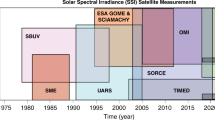Abstract
During the period 1957-1984 the annual age-adjusted incidence rate of cutaneous malignant melanoma (CMM) increased by 350% for men and 440% for women in Norway. The annual exposure to carcinogenic sunlight in Norway, calculated by use of measured ozone levels, showed no increasing trend during the same period. Thus, ozone depletion is not a cause of the increasing trend of the incidence rates of skin cancers. The incidence rates of basal cell carcinoma (BCC) and squamous cell carcinoma (SCC) increase with decreasing latitude in Norway. The same is true for CMM in Norway, Sweden, and Finland. Our data were used to estimate the implications of a future ozone depletion for the incidence rates of skin cancer: a 10% ozone depletion was found to give rise to a 16-18% increase in the incidence rate of SCC (men and women), a 19% increase in the incidence rate of CMM for men and a 32% increase in the incidence rate of CMM for women. The difference between the numbers for men and women is almost significant and may be related to a different intermittent exposure pattern to sunlight of the two sexes. The increasing trend in the incidence rates of CMM is strongest for the trunk and lower extremities of women, followed by that for the trunk of men. The increasing incidence rates of skin cancers as well as the changing pattern of incidence on different parts of the body is most likely due to changing habits of sun exposure. Comparisons of relative densities of CMM, SCC, LMM and SCC falling per unit area of skin at different parts of the body indicate that sun exposure is the main cause of these cancer forms although other unknown factors may play significant roles as well. For the population as a whole sun exposure during vacations to sunny countries has so far been of minor importance in skin cancer induction.
This is a preview of subscription content, access via your institution
Access options
Subscribe to this journal
Receive 24 print issues and online access
$259.00 per year
only $10.79 per issue
Buy this article
- Purchase on Springer Link
- Instant access to full article PDF
Prices may be subject to local taxes which are calculated during checkout
Similar content being viewed by others
Author information
Authors and Affiliations
Rights and permissions
About this article
Cite this article
Moan, J., Dahlback, A. The relationship between skin cancers, solar radiation and ozone depletion. Br J Cancer 65, 916–921 (1992). https://doi.org/10.1038/bjc.1992.192
Issue Date:
DOI: https://doi.org/10.1038/bjc.1992.192
This article is cited by
-
Cancer patterns in Iran: a gender-specific spatial modelling of cancer incidence during 2014–2017
BMC Cancer (2024)
-
The role of waste management in the control of hazardous substances: lessons learned
Environmental Sciences Europe (2012)
-
Fortgeschrittenes Karzinom der Lider
Der Ophthalmologe (2005)
-
Latitude gradients in melanoma incidence and mortality in the non-Maori population of New Zealand
Cancer Causes & Control (1994)
-
Genetic analysis of ultraviolet radiation-induced skin hyperplasia and neoplasia in a laboratory marsupial model (Monodelphis domestica)
Archives of Dermatological Research (1994)



